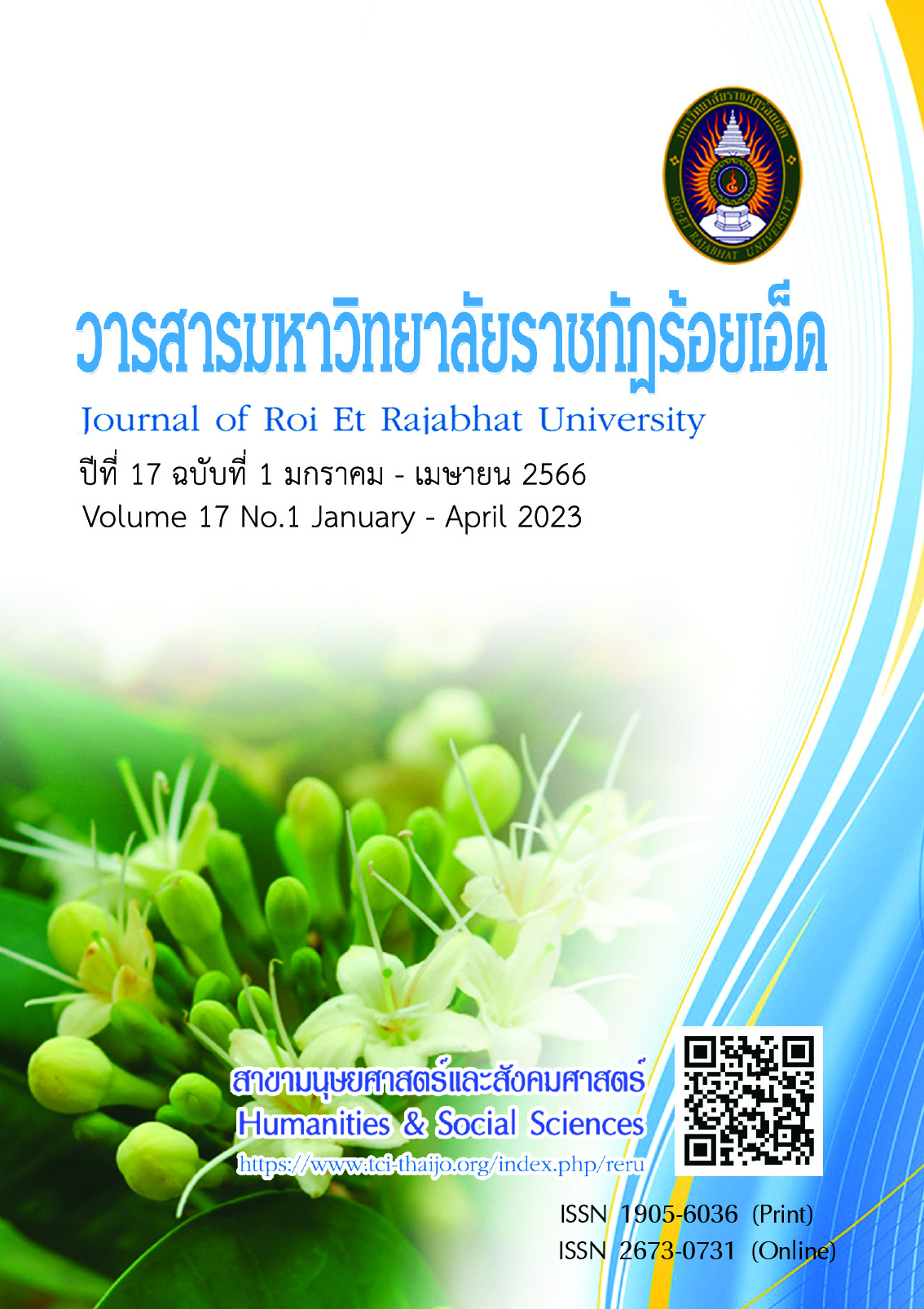A Study of Blended Learning Management during the COVID-19 Pandemic among Mathematics Students at Sisaket Rajabhat University
Keywords:
Blended learning management, COVID-19, Mathematics major studentsAbstract
This study aimed 1) to study blended learning management, 2) to compare opinions on blended learning management, and 3) to explore recommendations and guidelines for blended learning management during the COVID-19 pandemic among the Mathematics major students of Sisaket Rajabhat University.
The sample size was determined by percentage criteria. After that, proportional stratified random sampling was administered according to the population size at each year level. Finally, the sample group gained from the sampling method consisted of 113 students representing the 1st - the 4th year students of the Mathematics major. The sample students were enrolled in all the courses conducted with blended learning in the second semester of the academic year 2020. The main research instrument was a developed 5-Likert rating scale questionnaire containing 6 aspects and 36 questions and 1 open-ended question. Statistics for data analysis were frequency, percentage, mean, standard deviation, t-test, F-test, and Least Significant Difference.
The results are as follows. 1) The overall blended learning management was rated at a high level.
2) The students with different genders and year levels expressed different opinions on the overall blended learning management. 3) For recommendations and guidelines for further blended learning management, the students revealed that instructors should increase the efficiency of blended learning management
in terms of lesson content and materials. Students should improve their personal responsibility and self-discipline. The university should pay greater attention to the facilities and systems required to run online blended learning management. This will help develop various teaching and learning methods to fit future education.
References
กัลยาณี ตันตรานนท์ และ วิลาวัณย์ เตือนราษฎร์. (2560). ผลของการจัดการเรียนการสอนแบบผสมผสานต่อผลลัพธ์ในการเรียนรู้ในกระบวนวิชาวิทยาการระบาด. พยาบาลสาร, 44(3), 144-152.
เกวลี ผังดี และ พิมพ์ระดา ครองยุติ. (2556). ความพึงพอใจที่มีต่อการจัดการเรียนการสอนในหลักสูตรของภาควิชาสถิติ คณะวิทยาศาสตร์ มหาวิทยาลัยขอนแก่น. วิทยานิพนธ์ วิทยาศาสตรบัณฑิต สาขาวิชาสถิติ. ขอนแก่น: มหาวิทยาลัยขอนแก่น.
จารุวรรณ เทวกุล. (2555). ความพึงพอใจในการจัดการเรียนการสอนของนักเรียนระดับประกาศนียบัตรวิชาชีพ ประเภทวิชาพาณิชยกรรมชั้นปีที่ 1 ชั้นปีที่ 2 และชั้นปีที่ 3 วิทยาลัยอาชีวศึกษาฉะเชิงเทรา. วิทยานิพนธ์ การศึกษามหาบัณฑิต สาขาวิชาธุรกิจศึกษา. กรุงเทพฯ: มหาวิทยาลัยศรีนครินทรวิโรฒ.
ชนัญชิดา ทุมมานนท์, ปิยวรรณ วิเศษสุวรรณภูมิ, ชุติมา สุรเศรษฐ, จรินทร วินทะไชย, ชนิดา ตันติเฉลิม และดุสิตา ทินมาลา. (2564). ผลของการจัดการเรียนการสอนด้วยวิธีการเรียนรู้แบบผสมผสานที่มีต่อระดับการยึดมั่นผูกพันในการเรียนของนิสิตระดับปริญญาตรี. วารสารศึกษาศาสตร์ มหาวิทยาลัยนเรศวร, 23(2), 140-151.
ฐาปนีย์ ธรรมเมธา. (2557). อีเลิร์นนิง: จากทฤษฎีสู่การปฏิบัติ e-Learning: from theory to practice. กรุงเทพฯ: สำนักคณะกรรมการการอุดมศึกษา.
ทิศนา แขมณี. (2545). ศาสตร์การสอน: องค์ความรู้เพื่อการจัดกระบวนการเรียนรู้ที่มีประสิทธิภาพ. กรุงเทพฯ: สำนักพิมพ์แห่งจุฬาลงกรณ์มหาวิทยาลัย.
ปรมาภรณ์ เวียงวิเศษ และ ทวี สระน้ำคำ. (2560). ผลของบทเรียนแบบผสมผสานโดยใช้เทคนิคการเรียนรู้ร่วมกันของนักเรียนชั้นมัธยมศึกษาปีที่ 1 ที่มีโครงสร้างกลุ่มต่างกันเพื่อส่งเสริมการคิดวิเคราะห์. วารสารมหาวิทยาลัยราชภัฏร้อยเอ็ด, 11(1), 57-65.
ปิยาพร สินธุโคตร และ สุนทรี มอญทวี. (2563). ประสิทธิผลของการจัดการเรียนการสอนแบบผสมผสานต่อผลสัมฤทธิ์ทางการเรียนในรายวิชาการพยาบาลเด็กและวัยรุ่น 2 ของนักเรียนพยาบาลศาสตร์ชั้นปีที่ 3 วิทยาลัยพยาบาลกองทัพเรือ. วารสารแพทย์นาวี, 47(1), 158-171.
ภาษกร แจ่มหม้อ, สุริศักดิ์ ประสารพันธ์, วารีรัตน์ แก้วอุไร และเอื้อมพร หลินเจริญ. (2559). การพัฒนารูปแบบการจัดการเรียนรู้วิชาชีววิทยาแบบผสมผสานโดยใช้แหล่งข้อมูลเป็นหลัก เพื่อส่งเสริมความใฝ่เรียนรู้สำหรับนักเรียนชั้นมัธยมศึกษาตอนปลาย. วารสารศึกษาศาสตร์ มหาวิทยาลัยนเรศวร, 18(2), 37-49.
มนชิดา ภูมิพยัคฆ์, ทวี สระน้ำค้า และไชยยศ เรืองสุวรรณ. (2560). การพัฒนารูปแบบการเรียนบนเว็บผสมผสานด้วยเทคนิคการเรียนร่วมกันเพื่อพัฒนาทักษะการคิดอย่างมีวิจารณญาณของนักศึกษามหาวิทยาลัยราชภัฏ. วารสารมหาวิทยาลัยราชภัฏร้อยเอ็ด, 11(1), 38-47.
ศราวุธ เรืองสวัสดิ์, ปภาสินี แซ่ติ๋ว และ ปิยรัตน์ ชูมี. (2563). ผลการจัดการเรียนรู้แบบผสมผสานต่อทักษะการเรียนรู้แห่งศตวรรษที่ 21 สำหรับนักศึกษาพยาบาลศาสตร์วิทยาลัยพยาบาลบรมราชชนนี สุราษธานี. วารสารพยาบาลทหารบก, 21(1), 235-244.
เศรษฐา วีระธรรมานนท์ และอารีรัตน์ ใจประดับ. (2561). การพัฒนารูปแบบการจัดการเรียนรู้แบบผสมผสานในวิชาการถ่ายภาพดิจิทัล. วารสารปัญญาภิวัฒน์, 10(ฉบับพิเศษ), 227-240.
สมชาย บุญสุ่น. (2554). ความพึงพอใจของนิสิตที่มีต่อการเรียนการสอนของมหาวิทยาลัยมหาจุฬาลงกรณมหาวิทยาลัย จังหวัดพระนครศรีอยุธยา. พุทธศาสตรมหาบัณฑิต. พระนครศรีอยุธยา: มหาจุฬาลงกรณมหาวิทยาลัย.
อภิชาติ อนุกูลเวช. (2564). การเรียนแบบผสมผสาน (Blended Learning). สืบค้นเมื่อ 10 กันยายน 2564,
จาก http://abhichatdotcom.blogspot.com/2012/04/blended-learning.html
อภิรดี นันท์ศุภวัฒน์ และเรมวล นันท์ศุภวัฒน์. (2556). ความพึงพอใจและผลลัพธ์ของการจัดการเรียนการสอนแบบผสมผสานในกระบวนการวิชาภาวะผู้นำและการจัดการทางพยาบาล ของนักศึกษาพยาบาลคณะพยาบาล มหาวิทยาลัยเชียงใหม่. พยาบาลสาร, 40(ฉบับพิเศษ), 47-60.
อรวรรณ ธนูศร. (2561). ความพึงพอใจของนิสิตต่อการจัดการเรียนการสอนหลักสูตรการศึกษาบัณฑิตสาขาวิชาคณิตศาสตร์และวิทยาศาสตร์ มหาวิทยาลัยทักษิณ. สงขลา: มหาวิทยาลัยทักษิณ.
Allen, I. E., Seaman J. and Garrett, R. (2007). Blended in the Extent and Promise of Blended Education in the United State. Retrieved November 5, 2021, from https://www.bayviewanalytics.com/reports/blending-in.pdf
Anggoro, K. J. and Teerputon, D. (2018). The Intergration of Co-Teaching and Blended Learning to Improve Students’ English Skill in Thailand. Journal of Education Naresuan University, 20(3), 264-276.
Baczek, M., Zagancxyk-Baczek, M., Szpringer, M., Jaroszynski, A. and Wozakowska-Kaplon, B. (2021). Students’ Perception of Online Learning during the COVID-19 Pandemic: A Survey Study of Polish Medical Students. Medicine, 100(7).
Dhawan, S. (2020). Online Learning: A Panacea in the Time COVID-19 Crisis. Journal of Educational Technology Systems, 49(1), 5-22.
Fadillah, A., Nopitasari, D. and Pradja, P. B. (2020). Blended Learning Model During the Covid-19 Pandemic: Analysis of Student’s Mathematical Disposition. Jurnal Teori dan Aplikasi Matematika (JTAM), 4(2), 173-181.
He, J. and Freeman, L. A. (2010). Are Men More Technology- Oriented Than Women? The Role of Gender on the Development of General Computer Self-Efficacy of College Students. Journal of Information Systems Education, 21(2), 203-212.
Pokhrel, S. and Chhetri, R. (2021). A Literature Review on Impact of COVID-19 Pandemic on Teaching and Learning. Higher Education of the future, 8(1), 133-141.
Yan, M. D., Yulei, G. Z., Sury, R. and Talai, O. (2016). Examining Student Satisfaction and Gender Differences in Technology-Supported, Blended Learning. Journal of Information Systems Education, 27(2), 119-130.
Zhao, G. D. and Yuan, S. (2010). Factor Affecting Students’ Satisfaction in Blended Learning: the case of Peking Unersity. Distance Education in China, 6, 32-38.
Zhonggen, Y. (2021). The effects of gender, educational level, and personality on online learning outcomes during the COVID-19 Pandemic. International Journal of Educational Technology in Higher Education, 18(14), 1-17.
Downloads
Published
How to Cite
Issue
Section
License
Copyright (c) 2023 Roi Et Rajabhat University

This work is licensed under a Creative Commons Attribution-NonCommercial-NoDerivatives 4.0 International License.
บทความที่ได้รับการตีพิมพ์เป็นลิขสิทธิ์ของวารสารมหาวิทยาลัยราชภัฎร้อยเอ็ด
ข้อความที่ปรากฏในบทความแต่ละเรื่องในวารสารวิชาการเล่มนี้เป็นความคิดเห็นส่วนตัวของผู้เขียนแต่ละท่านไม่เกี่ยวข้องกับมหาวิทยาลัยราชภัฎร้อยเอ็ด และคณาจารย์ท่านอื่นๆในมหาวิทยาลัยฯ แต่อย่างใด ความรับผิดชอบองค์ประกอบทั้งหมดของบทความแต่ละเรื่องเป็นของผู้เขียนแต่ละท่าน หากมีความผิดพลาดใดๆ ผู้เขียนแต่ละท่านจะรับผิดชอบบทความของตนเองแต่ผู้เดียว





